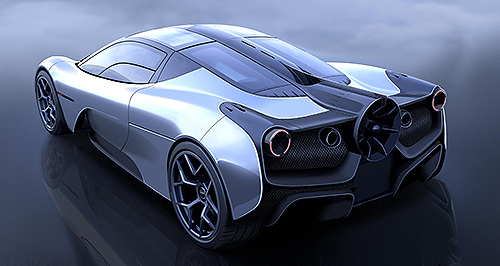Make / Model Search
Future models - Gordon Murray - T50Gordon Murray reveals T50 supercarRear drive: Gordon Murray has reprised technology from his Brabham Racing days with the ground-effects fan in his new T50 supercar. Ground-effects fan makes a comeback in Gordon Murray’s blistering T5011 Dec 2019 ONE-TIME formula one and McLaren Automotive designer Gordon Murray has gone back to the future by adopting a ground-effects fan to sharpen the aerodynamic downforce of his new supercar, the Gordon Murray Automotive T50.
Honed in partnership with the Silverstone-based Racing Point Formula One Team – formerly Force India – and revealed in images released in the United Kingdom overnight, the T50 is claimed to have the most advanced and effective aerodynamics of any road car.
The car is named in honour of Mr Murray’s 50 years as a designer of high-performance cars on the track and road.
Considered the spiritual successor to the Murray designed McLaren F1, the T50 is powered by a naturally aspirated 4.0-litre Cosworth V12 that revs to an eye-watering 12,400rpm and produces 484kW of power and 450Nm of torque – or even more with the assistance of a 48-volt electric starter motor-generator connected to the crankshaft that can produce a “push-to-pass” burst.
Just 125 of the cars will be built, with 25 of those destined for the track. Most T50s are said to have already been snapped up sight unseen at £2.3 million ($A4.4m) by cashed-up customers, many of them in the United States and Japan. Delivery is due to start in 2022.
The most innovative feature of the T50 is the ground-effects fan – a 40cm device protruding from the middle of the ‘boot’ – that sucks ‘dirty’ air from the car’s underside and blasts it out the back while revving at up to 8000rpm.
Powered by a 48-volt motor, the fan aids aerodynamic downforce by making the rear diffuser more effective while also maximising engine cooling and aerodynamic efficiency.
Ground effects technology using fans dates back to 1970 when American Jim Hall pioneered the “sucker system” on his Chaparral 2J race car
Mr Murray used a similar system when designing the Brabham BT46B formula one fan car which had a skirt around the car to increase the vacuum effect in 1978.
The car was later withdrawn from racing after it raised a furore in F1 ranks.
The T50 has no skirt, rather relying on the fan to channel the air more effectively through the back of the car from the underside, through ducts and straight out the back through the fan.
Combined with active aerofoils at the back of the car, the fan system provides six aero modes, including a slippery Streamline mode and also a braking mode that Mr Murray claims cuts 10 metres from the braking distance from 240km/h.
The High Downforce mode is said to increase downforce by 30 per cent. The modes can be set to automatic or selected by the driver.
Weighing just 980kg and built around a carbon-fibre monocoque, the mid-engined T50 has three seats with the driver sitting in the middle, flanked further back by two passengers.
Unlike most supercars today, the T50 gets a six-speed, H-pattern manual gearbox supplied by Xtrac.
No performance figures have yet been disclosed, as the car is still under development at the prototype stage.
The production version is scheduled to be unveiled in May next year, about the same time as Murray Automotive opens its customer experience centre at its Dunsfold Park headquarters.  All future models Alfa Romeo Alfa Romeo Abarth Abarth Alpine Alpine Alpina Alpina Audi Audi Aston Martin Aston Martin BMW BMW Bentley Bentley Chery Chery Brabham Brabham Chrysler Chrysler Chevrolet Chevrolet Cupra Cupra Citroen Citroen DS DS Dodge Dodge Fiat Fiat Ferrari Ferrari Foton Foton Ford Ford Great Wall Great Wall FPV FPV Haval Haval GWM GWM Honda Honda Holden Holden Hummer Hummer HSV HSV Infiniti Infiniti Hyundai Hyundai Jaguar Jaguar Isuzu Isuzu Kia Kia Jeep Jeep Land Rover Land Rover Lamborghini Lamborghini Lexus Lexus LDV LDV Mahindra Mahindra Lotus Lotus Mazda Mazda Maserati Maserati Mercedes-AMG Mercedes-AMG McLaren McLaren MG MG Mercedes-Benz Mercedes-Benz Mitsubishi Mitsubishi Mini Mini Opel Opel Nissan Nissan Peugeot Peugeot Pagani Pagani Proton Proton Porsche Porsche Renault Renault Ram Ram Rover Rover Rolls-Royce Rolls-Royce Skoda Skoda Saab Saab SsangYong SsangYong Smart Smart Suzuki Suzuki Subaru Subaru Toyota Toyota Tesla Tesla Volvo VolvoMotor industry news |
Click to shareGordon Murray modelsAll future models Alfa Romeo Alfa Romeo Abarth Abarth Alpine Alpine Alpina Alpina Audi Audi Aston Martin Aston Martin BMW BMW Bentley Bentley Chery Chery Brabham Brabham Chrysler Chrysler Chevrolet Chevrolet Cupra Cupra Citroen Citroen DS DS Dodge Dodge Fiat Fiat Ferrari Ferrari Foton Foton Ford Ford Great Wall Great Wall FPV FPV Haval Haval GWM GWM Honda Honda Holden Holden Hummer Hummer HSV HSV Infiniti Infiniti Hyundai Hyundai Jaguar Jaguar Isuzu Isuzu Kia Kia Jeep Jeep Land Rover Land Rover Lamborghini Lamborghini Lexus Lexus LDV LDV Mahindra Mahindra Lotus Lotus Mazda Mazda Maserati Maserati Mercedes-AMG Mercedes-AMG McLaren McLaren MG MG Mercedes-Benz Mercedes-Benz Mitsubishi Mitsubishi Mini Mini Opel Opel Nissan Nissan Peugeot Peugeot Pagani Pagani Proton Proton Porsche Porsche Renault Renault Ram Ram Rover Rover Rolls-Royce Rolls-Royce Skoda Skoda Saab Saab SsangYong SsangYong Smart Smart Suzuki Suzuki Subaru Subaru Toyota Toyota Tesla Tesla Volvo VolvoMotor industry news |









Facebook Twitter Instagram